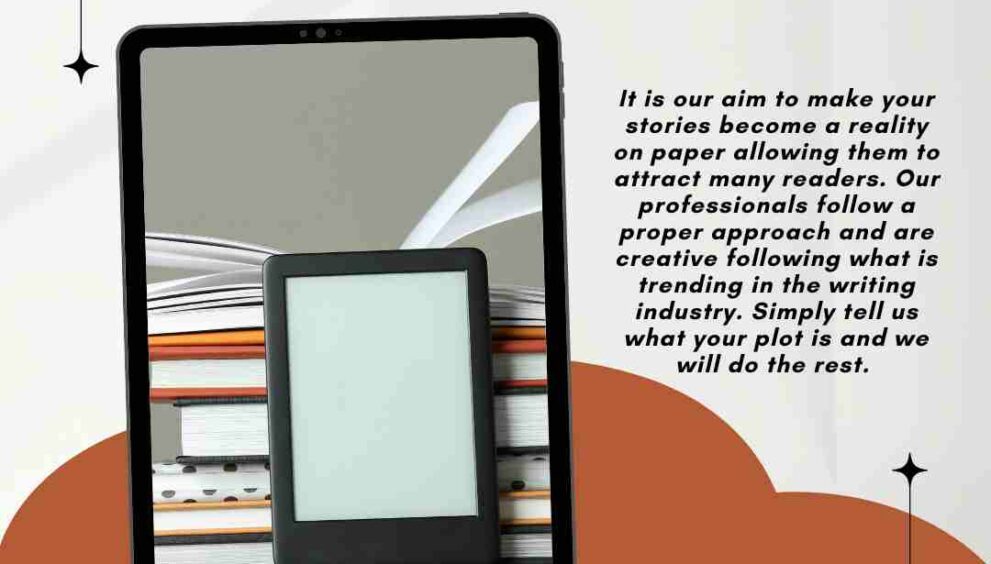E Book Formatting and Distribution
In the digital age, ebooks have become a popular and convenient medium for authors to share their stories with a global audience. However, the process of formatting and distributing ebooks can be complex and challenging. That’s where professional ebook publishing services come into play. In this comprehensive guide, we will explore the importance of e-book formatting and distribution, highlighting the role of professional services in simplifying these crucial steps.
The Significance of Ebooks in Publishing
Before we delve into ebook formatting and distribution, let’s understand why ebooks have become a significant part of the publishing landscape.
Accessibility
- Global Reach: Ebooks can be accessed and purchased from anywhere in the world, allowing authors to reach a diverse and international readership.
- Instant Access: Readers can acquire e-books instantly, eliminating the need to visit physical bookstores or wait for shipping.
Cost-Effectiveness
- Affordability: E-books are often more budget-friendly for readers, as they do not incur the costs of printing, shipping, or storage.
- Reduced Production Costs: For authors and publishers, ebooks reduce production expenses compared to traditional print books.
Eco-Friendly Publishing
- Reduced Environmental Impact: E-books are environmentally friendly, as they eliminate the need for paper, ink, and transportation.
- Sustainability: Authors can promote sustainable publishing practices by choosing digital formats.
Interactive Features
- Enhanced Reading Experience: Ebooks can include interactive features such as hyperlinks, multimedia elements, and dynamic content.
- Adaptability: These features can enhance educational and non-fiction ebooks, creating engaging and informative experiences.
The Role of eBook Formatting
Ebook formatting is the process of converting a manuscript into a digital format that is compatible with various eReaders and devices. It involves several key elements:
File Type and Compatibility
- File Format: E-books can be in various formats, such as ePub, MOBI, PDF, and more. Each format has its compatibility and features.
- Compatibility: Formatted e-books should be compatible with popular eReaders like Kindle, Nook, and Apple devices.
Structure and Layout
- Chapter Organization: The e-book’s chapters should be logically structured and easily navigable.
- Text Formatting: Ensure proper text formatting, including font styles, sizes, spacing, and alignment.
- Images and Multimedia: Any images or multimedia elements should be embedded correctly and should not disrupt the flow of the text.
Hyperlinks and Table of Contents
- Hyperlinks: Include hyperlinks for navigation within the ebook and external references, if applicable.
- Table of Contents: A functional and user-friendly table of contents allows readers to jump to specific sections.
Metadata
- Title and Author: Ensure that the e-book’s title and author information are embedded correctly in the metadata.
- Keywords and Descriptions: Include relevant keywords and descriptions that help readers find the ebook in online stores.
The Challenges of e-Book Formatting
E-book formatting can be challenging due to the variety of eReaders and devices, each with its unique requirements and capabilities. Authors and publishers often encounter the following difficulties:
Device Compatibility
- Diverse Devices: E-books must be formatted to display correctly on a wide range of devices, including eReaders, tablets, smartphones, and computers.
- Screen Sizes: Ensuring readability on small smartphone screens and large tablet screens can be a complex task.
Cross-Platform Consistency
- Font and Layout Consistency: Maintaining consistent fonts, spacing, and layout across platforms can be a technical challenge.
- Platform-Specific Features: Some platforms support enhanced features, while others do not, making it necessary to adapt the e-book accordingly.
Quality Control
- Testing and Quality Assurance: Extensive testing is needed to identify and fix any formatting issues across different devices and software.
- User Experience: Ensuring a seamless and enjoyable reading experience for readers is essential.
The Importance of Professional e-Book Formatting Services
Professional e-book formatting services play a vital role in addressing the challenges associated with formatting ebooks. Here’s how these services can streamline the process:
Multi-Device Compatibility
- Expertise: Professional formaters are well-versed in the specifications and requirements of various eReaders and devices.
- Optimization: They optimize the e-book for cross-device compatibility, ensuring a consistent reading experience.
Cross-Platform Consistency
- Formatting Expertise: Professional services have the expertise to maintain font and layout consistency across different platforms.
- Responsive Design: They create responsive designs that adapt to different screen sizes and resolutions.
Quality Assurance
- Thorough Testing: Professional formatters conduct thorough testing on various devices and eReaders to identify and rectify formatting issues.
- Reader Satisfaction: Their goal is to provide a formatting that ensures a smooth and enjoyable reading experience for readers.
eBook Distribution: Getting Your Work to Readers
Once your e-book is properly formatted, the next step is distribution. Ebook distribution involves making your digital book available to readers through various online channels. Here are key aspects to consider:
Distribution Platforms
- Online Retailers: Platforms like Amazon Kindle Direct Publishing (KDP), Apple iBooks, Barnes & Noble, and others allow authors to publish and sell their e-books.
- Aggregators: Distribution aggregators like Draft2Digital and Smashwords offer a convenient way to distribute ebooks to multiple retailers through a single platform.
- Author Websites: Authors can also sell e-books directly through their websites, providing full control over pricing and distribution.
Market Expansion
- Global Reach: Digital distribution allows authors to reach readers worldwide, transcending geographical boundaries.
- International Retailers: E-books can be distributed to international retailers, tapping into new markets and readers.
Pricing and Royalties
- Pricing Control: Authors have the flexibility to set their e-book prices, offering promotional discounts or free downloads as desired.
- Royalties: Earnings from ebook sales vary depending on pricing, distribution channel, and royalty rates.
Marketing and Promotion
- Metadata Optimization: Authors can use metadata to improve discoverability in online stores by selecting relevant keywords and categories.
- Promotional Strategies: Employ marketing and promotional strategies to boost e-book visibility and sales.
Copyright and DRM
- Copyright Protection: Authors can choose to apply copyright protection and digital rights management (DRM) to their ebooks to prevent unauthorized copying and distribution.
- Open Distribution: Authors may also opt for open distribution without DRM to allow greater reader flexibility.
Challenges in e-Book Distribution
Ebook distribution is not without its challenges, and authors and publishers may encounter the following issues:
Retailer Restrictions
- Exclusivity Agreements: Some retailers may require exclusivity, limiting the distribution of e-books to their platform for a specific period.
- Market Dominance: The dominance of certain retailers can limit distribution options for authors.
Pricing and Royalties
- Royalty Variations: Different distribution platforms offer varying royalty rates, affecting authors’ earnings.
- Price Matching: Price-matching policies can result in e-books being sold at lower prices on other platforms without the author’s consent.
Visibility and Discoverability
- Competitive Market: The crowded ebook marketplace can make it challenging for new or lesser-known authors to gain visibility.
- Marketing Costs: Authors may need to invest in marketing to enhance discoverability.
The Role of Professional e-Book Distribution Services
Professional e-book distribution services are instrumental in overcoming the challenges associated with distribution. Here’s how these services can assist authors and publishers:
Multi-Platform Distribution
- Retailer Access: Professional services have access to various distribution platforms, ensuring that ebooks reach a wide audience.
- Aggregator Integration: They can work with distribution aggregators to simplify the process of distributing e-books to multiple retailers.
Exclusivity Management
- Strategy Development: They can help authors develop distribution strategies, balancing exclusivity with broader distribution.
- Periodic Review: Services periodically review distribution agreements and make adjustments as needed.
Pricing and Royalty Optimization
- Pricing Guidance: Professional services provide guidance on pricing strategies to maximize royalties.
- Policy Compliance: They ensure that pricing and royalty agreements comply with the policies of each distribution platform.
Marketing and Promotion
- Metadata Enhancement: Professional services optimize metadata to enhance discoverability in online stores.
- Marketing Support: They may offer marketing and promotional services to boost the visibility of ebooks.
Marketing and Promotion of Ebooks
In addition to formatting and distribution, marketing and promotion are crucial for e-book success. Here are key marketing strategies:
Online Presence
- Author Website: Maintain an author website or blog to connect with readers and promote your e-books.
- Social Media: Utilize social media platforms to engage with your audience and share updates about your e-books.
Email Marketing
- Author Newsletter: Build an email list of readers interested in your work and send newsletters with updates and promotions.
- Ebook Offers: Provide exclusive offers and discounts to subscribers to encourage ebook sales.
Book Reviews and Blog Tours
- Review Outreach: Seek book reviews from bloggers and readers, which can enhance your book’s visibility and credibility.
- Blog Tours: Organize virtual blog tours to introduce your e-book to a wider audience.
Paid Advertising
- Online Ads: Consider running paid advertising campaigns on platforms like Facebook, Amazon, or BookBub to reach a targeted audience.
- Book Promotion Sites: Use book promotion sites to feature your e-book deals to a broad readership.
Collaboration and Cross-Promotion
- Author Collaborations: Collaborate with other authors for cross-promotion and joint marketing efforts.
- Genre and Niche Communities: Participate in genre-specific or niche communities to connect with potential readers.
Book Launch Strategies
- Pre-launch Buzz: Build anticipation for your ebook with pre-launch teasers, cover reveals, and countdowns.
- Launch Events: Organize virtual or in-person launch events to celebrate your ebook’s release.
Measuring Ebook Success
Ebook success can be measured through various metrics and indicators:
Sales and Revenue
- Sales Figures: Track the number of ebook sales to gauge its popularity.
- Earnings: Measure the revenue generated from ebook sales and royalties.
Reader Engagement
- Reviews and Ratings: Positive reviews and high ratings on platforms like Amazon can indicate reader satisfaction.
- Social Media Engagement: Monitor social media engagement, including likes, shares, comments, and interactions.
Online Presence
- Website Traffic: Analyze website traffic and engagement, including the number of visitors and page views.
- Newsletter Subscribers: Monitor the growth of your email list and newsletter subscribers.
Marketing Effectiveness
- Ad Campaign Performance: Evaluate the success of paid advertising campaigns by analyzing click-through rates and conversions.
- Newsletter Open Rates: Measure the effectiveness of email marketing by monitoring open rates and click-through rates.
Also Read: Finding Quality Healthcare: Government Hospital Near Me
Conclusion: Navigating the Digital Publishing Landscape
Ebook formatting and distribution are essential steps in the journey of publishing in the digital age. The accessibility and convenience of ebooks have revolutionized the way authors share their stories with the world, making it more crucial than ever to ensure that e-books are professionally formatted and effectively distributed.
Professional e-book publishing services play a pivotal role in simplifying the formatting and distribution process, offering authors and publishers the expertise needed to navigate the complexities of the digital publishing landscape. As you embark on your ebook publishing journey, remember that professional services are valuable allies in your pursuit of e-book success, ensuring that your stories reach a global audience and leave a lasting imprint in the world of digital publishing.






